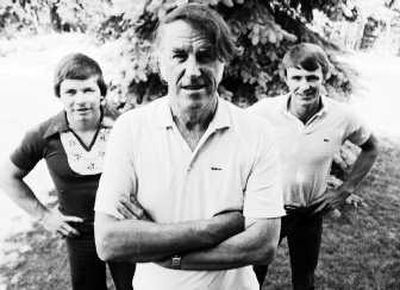King of largest hill, Hillary dies at 88

WELLINGTON, New Zealand – Sir Edmund Hillary, the unassuming beekeeper who conquered Mount Everest to win renown as one of the 20th century’s great adventurers, died today. He was 88.
The gangling New Zealander devoted much of his life to aiding the mountain people of Nepal and took his fame in stride, preferring to be called Ed and considering himself an “ordinary person with ordinary qualities.”
Hillary died at Auckland Hospital about 9 a.m. today from a heart attack, said a statement from the Auckland District Health Board. Though ailing in his later years, he remained active.
His life was marked by grand achievements, high adventure, discovery, excitement – but he was especially pround of his decades-long campaign to set up schools and health clinics in Nepal, the homeland of Tenzing Norgay, the mountain guide with whom he stood arm in arm on the summit of Everest on May 29, 1953.
Yet he was humble to the point that he only admitted being the first man atop Everest long after the death of Norgay.
He wrote of the pair’s final steps to the top of the world: “Another few weary steps and there was nothing above us but the sky. There was no false cornice, no final pinnacle. We were standing together on the summit. There was enough space for about six people. We had conquered Everest.
“Awe, wonder, humility, pride, exaltation – these surely ought to be the confused emotions of the first men to stand on the highest peak on Earth, after so many others had failed,” Hillary noted.
“But my dominant reactions were relief and surprise. Relief because the long grind was over and the unattainable had been attained. And surprise, because it had happened to me, old Ed Hillary, the beekeeper, once the star pupil of the Tuakau District School, but no great shakes at Auckland Grammar (high school) and a no-hoper at university, first to the top of Everest. I just didn’t believe it.”
He said: “I removed my oxygen mask to take some pictures. It wasn’t enough just to get to the top. We had to get back with the evidence. Fifteen minutes later we began the descent.”
Then, upon arriving back at base camp, he took an irreverent view: “We knocked the bastard off.”
His philosophy of life was simple: “Adventuring can be for the ordinary person with ordinary qualities, such as I regard myself,” he said in a 1975 interview after writing his autobiography, “Nothing Venture, Nothing Win.”
But Prime Minister Clark, announcing his death, said Hillary was anything but ordinary.
“Sir Ed described himself as an average New Zealander with modest abilities. In reality, he was a colossus. He was an heroic figure who not only ‘knocked off’ Everest but lived a life of determination, humility, and generosity. … The legendary mountaineer, adventurer, and philanthropist is the best-known New Zealander ever to have lived.”
Close friends described him as having unbounded enthusiasm for both life and adventure.
“We all have dreams – but Ed has dreams, then he’s got this incredible drive, and goes ahead and does it,” longtime friend Jim Wilson said in 1993.
Unlike many climbers, Hillary said when he died he had no desire to have his remains left on a mountain. He wanted his ashes scattered on Waitemata Harbor in the northern city of Auckland where he lived his life.
“To be washed gently ashore, maybe on the many pleasant beaches near the place I was born. Then the full circle of my life will be complete,” he said.
Funeral arrangements were not immediately announced.
In his 1999 book “View from the Summit,” Hillary finally broke his long public silence about whether it was he or Norgay who was the first man to step atop Everest.
“We drew closer together as Tenzing brought in the slack on the rope. I continued cutting a line of steps upwards. Next moment I had moved onto a flattish exposed area of snow with nothing by space in every direction,” Hillary wrote.
“Tenzing quickly joined me and we looked round in wonder. To our immense satisfaction we realized we had reached the top of the world.”
Before Norgay’s death in 1986, Hillary consistently refused to confirm he was first, saying he and the Sherpa had climbed as a team to the top. It was a measure of his personal modesty, and of his commitment to his colleagues.
Hillary never forgot the small mountainous country that propelled him to worldwide fame. He revisited Nepal constantly over the next 54 years.
Without fanfare and without compensation, Hillary spent decades pouring energy and resources from his own fundraising efforts into Nepal through the Himalayan Trust he founded in 1962.
Known as “burra sahib” – “big man,” for his 6 feet 2 inches – by the Nepalese, Hillary funded and helped build hospitals, health clinics, airfields and schools.
He raised funds for higher education for Sherpa families, and helped set up reforestation programs in the impoverished country. About $250,000 a year was raised by the charity for projects in Nepal.
A strong conservationist, he demanded that international mountaineers clean up thousands of tons of discarded oxygen bottles, food containers and other climbing debris that litter an area known as South Col valley, the jump-off point for Everest attempts.
His commitment to Nepal took him back more than 120 times. His adventurer son Peter has described his father’s humanitarian work there as “his duty” to those who had helped him.
It was on a visit to Nepal that his first wife, Louise, 43, and 16-year-old daughter Belinda died in a light plane crash March 31, 1975.
Hillary remarried in 1990, to June Mulgrew, former wife of adventurer colleague and close friend Peter Mulgrew, who died in a passenger plane crash in the Antarctic. He is survived by his wife, and children Peter and Sarah.